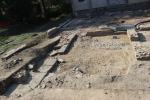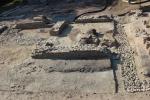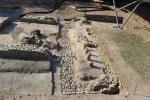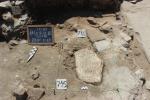Summary (English)
The 29th campaign of excavations in the Roman baths of Tifernum Mataurense in the locality of Colombaro at Sant’Angelo in Vado (PU) continued in ‘quadrant II’ in order to reach the earliest phase across the entire area, in part still covered by later layers. The excavation area was enlarged (max. length 18.20 m, max. width 11.30 m) with the intention of joining the structures in our trench to those investigated in the 1950s (not stratigraphically) and damaged by later cuts.
The resulting data suggested the presence of three phases: ancient, late/post antique and modern. The first is divided into three sub-phases: 1) early-late Republican/Augustan; II) early imperial/mid imperial; III) mid imperial/late antique.Sub-phase I was represented by a sewer system comprising two separate channels, and a row of large sandstone blocks, probably the base of a colonnade, to which fragmentary columns in the same material found reused in past campaigns may have belonged. The level, stratigraphic context, alignment and construction technique imply there were already organised structures in the area in the first half of the 1st century B.C.
There followed the construction of the baths ( calidarium, tepidarium, frigidarium ) and probable gymnasium, extending to the south, where a monumental western entrance emerged in the trench. It was built on the pre-existing foundation with brick columns and pilasters plastered in red (diam. 0.58 m; intercolumniation c. 2.70 m), of which one in situ that emerged this year (max. preserved height c. 45 cm); other very fragmentary ones were found in the 1950s. The colonnade probably extended to the south to form a distyle façade ?in-antis. The north side of the gymnasium was closed by a structure of small blocks with a quadrangular niche. Within the gymnasium was the probable natatio lined with opus signinum, at a tangent and parallel with the north wall, of which part of the west wall was present in the trench. The plan, construction technique, finds, level and stratigraphic relationships date this phase to the mid 1st century B.C.
A phase of monumentalisation also dates to the late Republican and Augustan periods. This involved the construction of an apse (diam. 9.20 m), today in sub-foundation, abutting the exterior of the calidarium south wall, and a room (4.00 m long) between the apse and swimming pool, perhaps the destrictarium.
Sub-phase II, is loosely datable to between the late 1st century A.D. and the early 2nd century A.D. It consisted of changes to the previous layout, such as the construction on the gymnasium, apse and destrictarium of the already known heated room with hypocaust and praefurnium and the re-flooring of the calidarium and tepidarium with bipedales, made by Pla.C.F.Proculae and Act.Attico (104 A.D.).Sub-phase II was represented by accumulations of building rubble and a substantial clayey layer (25-30 cm deep). The physical characteristics and material finds, including glazed middle- Adriatic pottery, and an inscription (32.5 × 30 × 4.8 cm) with a fragmentary dedication to a high-ranking army officer, indicate collapses and alluvial events between the second half of the 2nd century A.D. and the 3rd century A.D. A raising of the floor surface in opus signinum in the western sector could attest the momentary restoration of the area, however, this was soon followed by the abandonment of the complex, and the reuse of the building materials for later floors (excavated last year).
The large irregular pit in the south-eastern part of the trench dates to the late antique/post-antique phase. Of indeterminate function, it cut deep into the existing stratigraphy and the subsoil in the south-eastern corner. It contained pottery dating to the 5th-7th century A.D.
- Emanuela Stortoni- Ricercatore di Archeologia e Storia dell’Arte greca e romana del Dipartimento di Scienze della Formazione, dei Beni Culturali e del Turismo dell’Università degli Studi di Macerata.
Director
- Emanuela Stortoni- Ricercatore di Archeologia e Storia dell’Arte greca e romana del Dipartimento di Scienze della Formazione, dei Beni Culturali e del Turismo dell’Università degli Studi di Macerata
Team
- Francesca Eugenia Damiani
- Alberto Baldoni
- Alberto Baldoni
- Alessandra Volpi
- Silvia Forti
Research Body
- Università degli Studi di Macerata
Funding Body
- Comune di Sant’Angelo in Vado
- Università degli Studi di Macerata






![Download [PDF]](/excavation/skins/fasti/images/results/download_sml.png)



